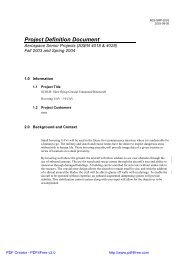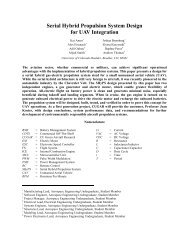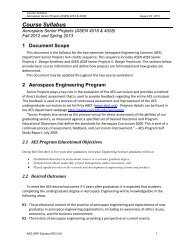PFR - Aerospace Engineering Sciences Senior Design Projects ...
PFR - Aerospace Engineering Sciences Senior Design Projects ...
PFR - Aerospace Engineering Sciences Senior Design Projects ...
You also want an ePaper? Increase the reach of your titles
YUMPU automatically turns print PDFs into web optimized ePapers that Google loves.
Project Final Report – CUDBF April 30 th , 2009<br />
ASEN 4028: <strong>Aerospace</strong> <strong>Senior</strong> <strong>Projects</strong><br />
extensive repair time to account for varying sized parts throughout the wing. Due to the time<br />
savings during the construction and repair of a balsa-foam composite wing, this construction<br />
method was selected as the final design selection<br />
5.4.2 Wing Span Reduction Method and Joint Location<br />
The existence of both the span-wise minimum wing span and the maximum aircraft container<br />
dimensions made it impossible to employ a traditional solid single-piece wing. Some form of<br />
wing span reduction is necessary in the design to meet both span and container requirements.<br />
The primary decision parameters for wing span reduction included minimizing assembly time<br />
(the most significant mission score component), and design/manufacturing complexity. The<br />
most sensitive score component at competition is derived from assembly time, and any reduction<br />
in total assembly time is given the highest priority and preference. The design and<br />
manufacturing complexity is important for reducing failure opportunities and improving<br />
performance and construction consistency.<br />
The two primary methods considered as design options for total wing span reduction were wing<br />
folding and wing disassembly. Wing folding involves the use of hinges at a fold joint to allow a<br />
wing section to either fold upwards or downwards to reduce the span-wise length. Wing<br />
disassembly splits the wing into multiple sections that would come apart for container storage<br />
and reassemble into a complete wing. Both the wing folding and wing disassembly design<br />
concepts are provided within Figure 26.<br />
Figure 26: Wing Span Reduction <strong>Design</strong> Options<br />
The wing folding solution presents many advantages over wing disassembly, particularly with<br />
respect to the important aircraft assembly time derived from the mission sensitivity analysis.<br />
With a hinged folding wing, the handler only needs to repeat one simple swinging motion to<br />
reposition the wings into flight ready position. Another advantage to a folding wing is that any<br />
wiring across the fold location does not need to separate and reconnect repeatedly. A<br />
disassembled wing not only requires time for reassembly of various individual components, but<br />
has increased assembly time and complexity to realign components and reconnect any<br />
44
















